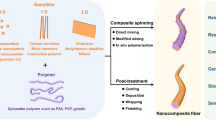Abstract
The behavior of high-strength, high-modulus filled fibers based on aromatic polyamide with heterocyclic fragments was investigated at high temperatures. It was shown that a slight shift in the critical points on the thermomechanical curves to the region of higher temperatures is characteristic of fibers filled with rare-earth element oxides. The glass transition temperature, heat resistance, and thermal stability increase in the filled fibers. These changes are characteristic of fibers containing more than 10 wt. % filler.
Similar content being viewed by others
References
Yu. S. Lipatov, Physical Chemistry of Filled Polymers [in Russian], Khimiya, Moscow (1977), p. 17.
V. A. Belyi and Yu. M. Plekachevskii, Metal-Containing Polymer Systems [in Russian], Khimiya, Moscow (1982), p. 26.
L. O. Bunina, G. I. Kessler, et al., Dokl. Akad. Nauk, 253, 902 (1980).
S. P. Papkov, Khim. Volokna, No. 3, 8–12 (1983).
S. N. Zhurkov, A. Ya. Savostin, and E. E. Tomashevskii, Dokl. Akad. Nauk, 159, 303 (1964).
Additional information
All-Russian Scientific-Research Institute of Polymer Fibers, Mytishchi. Translated from Khimicheskie Volokna, No. 4, pp. 42–45, July–August, 1992.
Rights and permissions
About this article
Cite this article
Zhuravleva, A.I., Osipov, N.P., Galeeva, I.I. et al. Thermal characteristics of organic high-strength, high-modulus fibers containing finely disperse fillers. Fibre Chem 24, 307–311 (1993). https://doi.org/10.1007/BF00550859
Issue Date:
DOI: https://doi.org/10.1007/BF00550859




